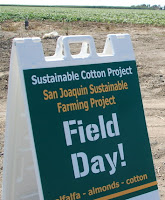Sounding like a broken record – or faulty CD – field
scout Jenna Mayfield continues to repeat her message over and over to almond
growers.
This
time, though, Jenna makes another case after continuing to spot harvested
orchards with trees littered with leftover nuts hanging on the trees: Watch out
for pesky squirrels and other rodents in the future.
 |
| Squirrels can be troublesome for growers. (UC IPM photo) |
“In years past, we had so many squirrels in
orchards. They will come before June,” Jenna says. Leaving nuts on the trees
can become an invitation to these crop-damaging critters to bunk down in the
orchards during their winter hibernation.
In
the Central Valley, ground squirrels breed from February through April and
average seven to eight per litter, according to UC IPM. Normally, they will eat
grasses and plants after waking up from their hibernation. Almonds become the
squirrel’s food du jour after the nuts start to dry in the summer.
So here’s the catch. The squirrels may stick around
and raise their family in the orchard if there are nuts from the previous
season still in the trees.
 |
| Here is evidence of ground squirrel damage in an almond tree. |
Of course, we can’t forget to mention once more that
mummy nuts also become home to overwintering navel orangeworm.
“There
are still trees with lots of nuts. It’s important to get your post-harvest work
done. Don’t put it off,” Jenna said. If
growers don’t have a hand pole crew available, Jenna suggests going out with a
leaf blower knock off the remaining nuts.
 |
| Stink bugs are showing up in almonds. (UC IPM photo) |
Meanwhile, Jenna reports spotting stink bugs in the
orchards. “That’s kind of odd.”
Normally, stink bugs are a threat from May through July. They will
pierce through a hull into a kernel, causing the nut to become wrinkled or
misshaped.
Black spots
will show up on hardened kernels. Jenna
will continue to monitor this development.
In the fields, field scout Carlos Silva says many
alfalfa growers are poised to extend the season into the early fall. Those who
wrapped up another cutting this month, are now irrigating their fields.
“They’re still planning to go into October.”









